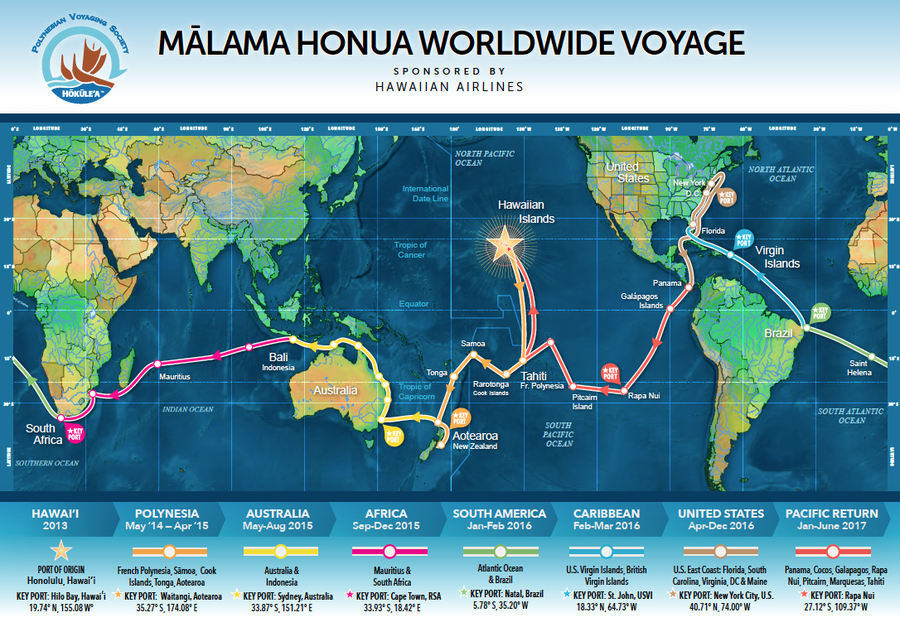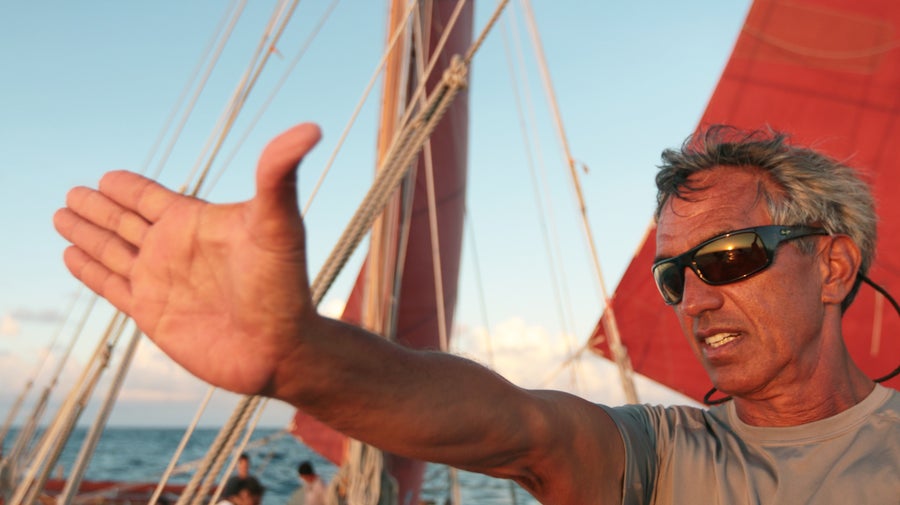On June 17, a 62-foot-long double-hulled canoe is slated to arrive in Honolulu, completing the first-ever round-the-world voyage by a traditional Polynesian vessel—a predecessor of the modern catamaran.
The trip began in May 2014 when the Hōkūleʻa (Hawaiian for Arcturus, a guiding zenith star for seafarers) sailed westward from Hilo on Hawaii’s Big Island. Since then it has plied five oceans, visited 19 countries and traversed more than 40,000 nautical miles.
Nainoa Thompson, president of the Polynesian Voyaging Society, which organized the expedition, has called oceangoing vessels like the Hōkūleʻa “the spaceships of our ancestors,” adding, “If you took all of the genius that has allowed us to put a man on the moon and applied it to an understanding of the ocean, what you would get is Polynesia.”
On supporting science journalism
If you're enjoying this article, consider supporting our award-winning journalism by subscribing. By purchasing a subscription you are helping to ensure the future of impactful stories about the discoveries and ideas shaping our world today.
The round-the-world journey was planned in part to celebrate Polynesia’s seafaring achievements in developing and using a unique form of traditional navigation. During an era when most Western sailors still feared to leave sight of shore because they had not yet developed a way of determining longitude, Pacific islanders were already routinely crisscrossing a region spanning 25 million square kilometers—an oceanic world covering nearly one quarter of Earth’s surface—according to Wade Davis, an Explorer-in-Residence at the National Geographic Society and author of The Wayfinders: Why Ancient Wisdom Matters in the Modern World.

Voyage Map of Hōkūle‘a. Credit: Polynesian Voyaging Society
For much of the 20th century, anthropologists assumed the thousands of far-flung islands of the Pacific were settled after being accidentally found by sailors who were driven off course by storms. But native Polynesians have long argued, based on their oral traditions and nautical lore, that settlement was the result of deliberate journeys of exploration and colonization undertaken by highly skilled navigators. “For centuries, Europeans stubbornly refused to acknowledge Polynesian achievements because they simply could not believe that a so-called primitive society was demonstrably better at navigation than they were,” Davis says.
Thompson was trained in the vanishing Pacific art of “wayfinding” by Mau Piailug of Micronesia—one of the last of the traditionally schooled navigators—who died in 2010. Following Piailug’s instructions, the Hōkūleʻa has been guided entirely without modern navigational aids such as nautical charts, compasses and GPS, instead relying on observation of the position of celestial bodies, the direction of waves and the movement of seabirds to set its course. To accurately maintain their bearing at night, the Hōkūleʻa navigators had to memorize the nightly courses of more than 200 stars, along with their precise rising and setting locations on the horizon.
Although ancient in design, the Hōkūleʻa was constructed in part from modern materials including plywood, which has replaced the scarce seasoned Hawaiian koa wood that would have framed the hulls of ancestral craft. The craft also has Dacron sails instead of ones woven from traditional lauhala leaves. The 17-member rotating crew, whose members each served monthlong stints, supplemented their packaged foods and water with fish they caught during the voyage and rainwater.
The current circumnavigation is the latest and most ambitious of a series of interisland journeys that have taken place since the Hōkūleʻa was first launched in 1975. Transoceanic voyages like the present one are believed to have largely ended in Polynesia with European contact more than four centuries ago, and many Polynesians credit the current revival of long-distance canoe voyages with having initiated a cultural renaissance.
Anthropologists have long debated how the Pacific islands—separated by thousands of miles of open ocean—were first settled. In 1947 Norwegian adventurer Thor Heyerdahl sailed the balsa wood raft Kon-Tiki from the Peruvian coast to Polynesia to advocate his idea the region was colonized from the east by descendants of the Incas. Heyerdahl’s theory, however, has been widely contradicted by more recent linguistic and ethnobotanical evidence that indicates human migration began in Southeast Asia and proceeded eastward in stages to Melanesia and then to the islands of Micronesia and Polynesia over the course of several millennia.
In their effort to retrace ancient voyages the Hōkūleʻa crew learned the habits of land-based seabirds in order to better assess their distance from islands: to them, a white tern meant land was within 200 kilometers whereas boobies rarely venture more than 40 kilometers from the shore. The crew was also taught to read cloud patterns, sunset colors and the size of halos around stars to learn what such phenomena might portend about approaching weather.
The crew’s ancient predecessors purportedly had even more nuanced methods of reading the physical environment for navigational cues. Davis says islands in the Pacific create their own unique wave patterns according to factors like coastal shape, just as bells of different sizes and materials create distinctive sounds. Highly experienced Polynesian navigators of old could know which island they were approaching based on the fingerprint-like resonance of the waves it radiates, Davis adds. “There are skill sets that humans have acquired when needs demand it that are lost when they are no longer relevant,” he says. By feeling the beat of water against the hulls of their vessels, traditional Polynesian navigators like Mau Piailug could determine the size and direction of up to five different ocean swells, helping them to orient themselves and detect the approach of distant weather, Davis explains.

Master navigator Nainoa Thompson measuring the sun at sunset, which is one of the most critical times of day for non-instrument navigators. Credit: Ōwi TV, and Polynesian Voyaging Society
“If science is based on inquiry, observation and exploration, then the ancient Polynesians were supreme ocean scientists,” Thompson says. He adds, however, that navigators did more than just accumulate objective knowledge about the natural world. He tells the story of his teacher Piailug, whose grandfather (also a navigator) used to throw young Piailug into the sea so the boy could “know the waves from the inside.” According to Thompson, “The difference between Mau’s science and modern science is that modern science separates itself from its objects of observation. In Mau’s science you are the waves, you are the wind, you are the stars.” He contends this can lead to a state of “knowing without knowing how you know,” in which navigators can make the right decisions when there are few cues that others would find obvious.
The voyages of the Hōkūleʻa over the decades have been eagerly followed by islanders throughout the Pacific. Former crew member Sam ‘Ohu Gon, a senior science and cultural advisor for the Nature Conservancy of Hawaii, believes they have helped to restore pride in Polynesian culture, which had been suppressed during the centuries of colonial rule. “It sparked a realization that the peoples of the Pacific are not separated by the oceans but connected by them,” Gon says.
For example, the teaching of Hawaiian language in public schools was long banned, and according to Gon the last exclusive native speakers were dying in the 1960s. “But due in large part to the inspiration of these voyages, which have become a symbol of Hawaiian identity,” he says, “the language is now being revived and taught in high schools and language-immersion schools throughout Hawaii.” In 1996 Hawaiian was established as an official state language, allowing it to be used to draft documents and legislation.
Gon goes on to say the goal of the Hōkūleʻa voyages has shifted away from merely demonstrating the power of traditional knowledge to advocating for environmental protection. The latest round-the-world voyage, called “Mālama Honua” (which in Hawaiian means “to care for our island Earth”) aims especially to focus public attention on the worsening plight of the world’s oceans.
Thompson says he has seen big changes in the sea since he started voyaging in the 1970s. Nowadays when the crew fishes to supplement their diet, the catch is meager. “We recently sailed 1,100 [kilometers] from Mauritius to Madagascar without catching a single fish,” he says. “Fully 90 percent of the edible fish have already been taken out of the seas.”
Reefs, which feed and protect the inhabitants of small islands, are bleaching yearly in many places. Thompson finds a sense of gloom and depression has descended in many of these areas. “We’ve had so many painful conversations with folks who know they are going to lose their islands due to climate change,” he says.
Chip Fletcher, a coastal geologist at the University of Hawaii at Manoa who has served as one of Thompson’s scientific collaborators, believes “the immediate threat is not that sea level rise is drowning the atolls and low-lying islands of the Pacific but that saltwater is already bubbling up into aquifers, challenging the freshwater capacity on which coastal communities depend.”
Fletcher says sea level rise is happening three times faster this century than the average during the previous one, with some recent models suggesting levels in the Pacific may be two or even three meters higher by the end of the century. Dangerous hurricanes are also proliferating and moving into more temperate regions as warming causes the tropical zone to expand. Hawaii itself has experienced more frequent and larger storms in recent years, Fletcher says. And droughts, a real threat to freshwater-poor islands, are increasing as El Niño weather systems become more severe.
“The irony is that the Pacific islands have nothing to do with creating climate change but they are the ones who are suffering the most,” Thompson says. But he is optimistic that the looming crisis has sparked an unprecedented awakening. “It is the Pacific's time,” he says. "The good news is that we found thousands of people there full of aloha, full of compassion and caring for the Earth and for the oceans, which give us our life. The news from the Pacific is not good. Yet the spirit of the people we met on the voyage leaves me feeling incredibly strengthened and inspired.”